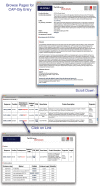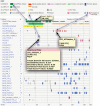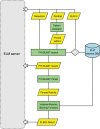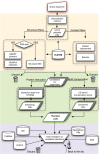ELM: the status of the 2010 eukaryotic linear motif resource
- PMID: 19920119
- PMCID: PMC2808914
- DOI: 10.1093/nar/gkp1016
ELM: the status of the 2010 eukaryotic linear motif resource
Abstract
Linear motifs are short segments of multidomain proteins that provide regulatory functions independently of protein tertiary structure. Much of intracellular signalling passes through protein modifications at linear motifs. Many thousands of linear motif instances, most notably phosphorylation sites, have now been reported. Although clearly very abundant, linear motifs are difficult to predict de novo in protein sequences due to the difficulty of obtaining robust statistical assessments. The ELM resource at http://elm.eu.org/ provides an expanding knowledge base, currently covering 146 known motifs, with annotation that includes >1300 experimentally reported instances. ELM is also an exploratory tool for suggesting new candidates of known linear motifs in proteins of interest. Information about protein domains, protein structure and native disorder, cellular and taxonomic contexts is used to reduce or deprecate false positive matches. Results are graphically displayed in a 'Bar Code' format, which also displays known instances from homologous proteins through a novel 'Instance Mapper' protocol based on PHI-BLAST. ELM server output provides links to the ELM annotation as well as to a number of remote resources. Using the links, researchers can explore the motifs, proteins, complex structures and associated literature to evaluate whether candidate motifs might be worth experimental investigation.
Figures






Similar articles
-
ELM server: A new resource for investigating short functional sites in modular eukaryotic proteins.Nucleic Acids Res. 2003 Jul 1;31(13):3625-30. doi: 10.1093/nar/gkg545. Nucleic Acids Res. 2003. PMID: 12824381 Free PMC article.
-
A structure filter for the Eukaryotic Linear Motif Resource.BMC Bioinformatics. 2009 Oct 24;10:351. doi: 10.1186/1471-2105-10-351. BMC Bioinformatics. 2009. PMID: 19852836 Free PMC article.
-
ELM-the Eukaryotic Linear Motif resource-2024 update.Nucleic Acids Res. 2024 Jan 5;52(D1):D442-D455. doi: 10.1093/nar/gkad1058. Nucleic Acids Res. 2024. PMID: 37962385 Free PMC article.
-
Computational prediction of protein-protein interactions.Methods Mol Biol. 2004;261:445-68. doi: 10.1385/1-59259-762-9:445. Methods Mol Biol. 2004. PMID: 15064475 Review.
-
Identification of motifs in protein sequences.Curr Protoc Cell Biol. 2001 May;Appendix 1:Appendix 1C. doi: 10.1002/0471143030.cba01cs00. Curr Protoc Cell Biol. 2001. PMID: 18228275 Review.
Cited by
-
Protein-peptide complex crystallization: a case study on the ERK2 mitogen-activated protein kinase.Acta Crystallogr D Biol Crystallogr. 2013 Mar;69(Pt 3):486-9. doi: 10.1107/S0907444912051062. Epub 2013 Feb 16. Acta Crystallogr D Biol Crystallogr. 2013. PMID: 23519423 Free PMC article.
-
Potential role of chimeric genes in pathway-related gene co-expression modules.World J Surg Oncol. 2021 May 12;19(1):149. doi: 10.1186/s12957-021-02248-9. World J Surg Oncol. 2021. PMID: 33980272 Free PMC article.
-
Human metapneumovirus M2-2 protein inhibits innate cellular signaling by targeting MAVS.J Virol. 2012 Dec;86(23):13049-61. doi: 10.1128/JVI.01248-12. Epub 2012 Sep 26. J Virol. 2012. PMID: 23015697 Free PMC article.
-
HIV protein sequence hotspots for crosstalk with host hub proteins.PLoS One. 2011;6(8):e23293. doi: 10.1371/journal.pone.0023293. Epub 2011 Aug 15. PLoS One. 2011. PMID: 21858059 Free PMC article.
-
FOXP in Tetrapoda: Intrinsically Disordered Regions, Short Linear Motifs and their evolutionary significance.Genet Mol Biol. 2017 Jan-Mar;40(1):181-190. doi: 10.1590/1678-4685-GMB-2016-0115. Epub 2017 Mar 2. Genet Mol Biol. 2017. PMID: 28257525 Free PMC article.
References
-
- Diella F, Haslam N, Chica C, Budd A, Michael S, Brown NP, Trave G, Gibson TJ. Understanding eukaryotic linear motifs and their role in cell signaling and regulation. Front. Biosci. 2008;13:6580–6603. - PubMed
-
- Neduva V, Russell RB. Peptides mediating interaction networks: new leads at last. Curr. Opin. Biotechnol. 2006;17:465–471. - PubMed
-
- Petsalaki E, Russell RB. Peptide-mediated interactions in biological systems: new discoveries and applications. Curr. Opin. Biotechnol. 2008;19:344–350. - PubMed
Publication types
MeSH terms
LinkOut - more resources
Full Text Sources
Research Materials

